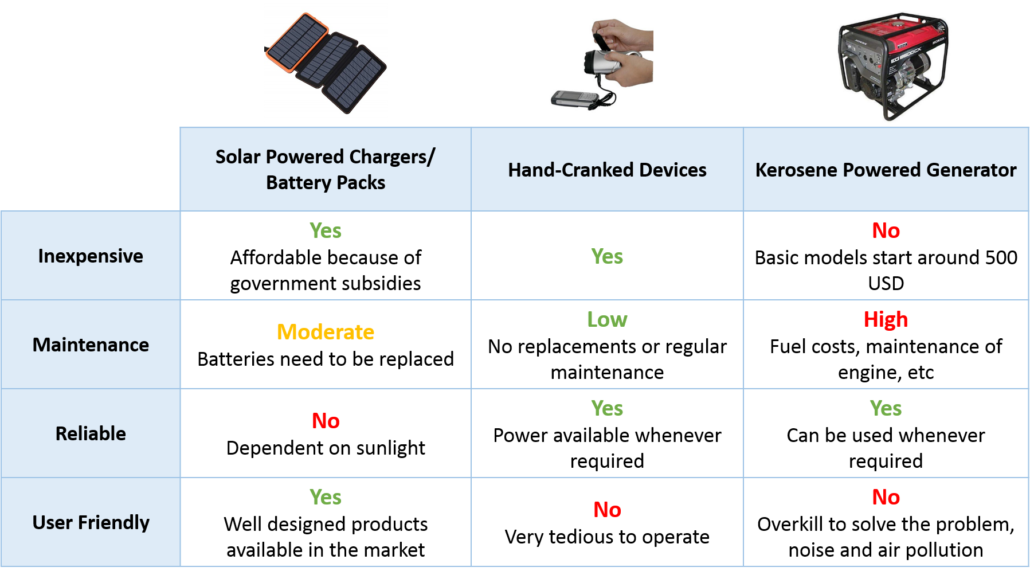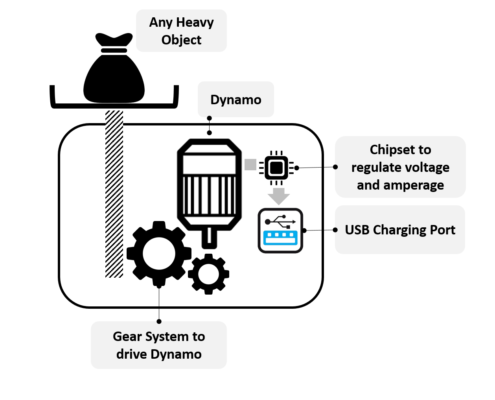GravityCharger: An Off-grid Mobile Charger
While on a vacation, I was driving through a village in central India and stopped for a break at the local market. The most interesting thing that caught my eye was a cart with big batteries and close to a dozen mobile phones placed on it. It was strange to see this assortment in the middle of a local market, and I went to talk to the cart owner to know exactly what he was selling. Guess what the service was? He was not selling any product, he was selling electricity. Any customer can come and charge their phone and pay for every 15 minutes slot the phone gets charged.
Later I got to know these kind of setups can be found not only in Indian villages but in many other pockets of Asia and Africa. And the key reason that they exist is that there still many areas where people have access to smartphones and mobile signals but not to reliable electricity supply.
Internet access is one of the biggest factor that has positively impacted the lives of people across the globe. However, the people who can benefit the most from internet access, are having trouble to do so despite having the right tools just because of not being able to charge their phones.
I decided to come up with a product concept to solve the problem: “How to generate sufficient electricity to charge a phone, without relying on the grid, in a cheap and reliable manner?”
Evaluating existing options
The ideal product/solution should be:
- Inexpensive, as the target users are expected to have limited spending power
- Low to zero maintenance, as the users might be located in remote locations with limited access to service centers/spare parts
- Able to produce electricity reliably, with no dependence on external factors
- User friendly to ensure mass user adoption
A quick Google search revealed that there are a lot of alternatives available to provide off-grid lighting and power storage, but most of them fail to deliver on at least one of the factors mentioned above.

Gravity to the rescue
The challenges with the existing alternatives were not because of the product design, but because of the intrinsic properties of the the source of energy they were using. So, instead of designing a better product that relied on these sources of energy, I needed to find an alternative clean source of energy that is more reliable and freely available.
I realized that gravity scored well on all the evaluation factors. It is free, available everywhere and among the most consistent of all nature’s forces. If a product can be designed to somehow harness gravity in a convenient manner, we might have a solution to the problem.
Product Concept
The device could either utilize pulleys or gears to convert the downward force on weights raised to a height to turn a dynamo which in turn would produce electricity. As a user, I would just gather around some rocks or put sand in bags and place them on a pan or hang them from a hook and just start charging my phone. A rough concept diagram would look like this:
But there are certain design challenges that I have not covered. The feasibility of a production grade product would depend upon whether sufficient power to charge a phone (approx 5 W) can be produced with a manageable weight and a convenient reset cycle (lifting the weight again to restart the power supply). Also, once the balance has been achieved, the design would require multiple iterations so that the end product looks like a gadget in a household rather than an experiment in the middle of somebody’s home.
Closing Notes
Please comment if you would like to share your thoughts on the feasibility of such a device. Also, I would love to hear your ideas on what are some other ways in which gravity can be used for household applications.





